2015 Breadth Versus 2007, 2008, 2010, and 2011
Market breadth speaks to the percentage of stocks participating in a stock market rally. All things being equal, the broader the participation the healthier the market. In this article, we will examine breadth for both the S&P 500 and NYSE Composite Stock Index. We will also examine 2015 breadth vs. similar points after a correction and similar points in a bear market. Stock market breadth is not particularly useful as a short-term timing tool for the S&P 500; it can be helpful on longer-term time horizons.
2015 Breadth Versus 2010-2011
The S&P 500 bottomed on September 29, 2015 or 69 calendar days ago. It is common for breadth to become weak during a correction and then improve after a bottom is reached. Therefore, we can gain some insight into 2015 by comparing breadth figures in 2010 and 2011 69 calendar days after the stock market made a low. As the summary table below shows, 2015 breadth is not significantly different than at similar points during the 2010 and 2011 rallies. In fact, in some cases 2015 breadth is better.
Did Bear Markets Begin In 2010 or 2011?
The answer to the question above is no. Therefore, if 2015 breadth is similar to breadth in 2010 and 2011, it is difficult to say 2015 breadth is screaming “a bear market is imminent”. Our purpose here is not to say 2015 breadth is bullish, but rather to say:
Stock market breadth is not that bad right now relative to recent corrections. The jury is still out on the bull market vs. bear market question based on market breadth.
S&P 500 Stocks Greater Than 50-Day Moving Average
The 50-day moving average helps us monitor the health of short to intermediate-term trends. In 2010 69 days after the correction ended, 67% of S&P 500 stocks were above their 50-day moving average. In 2011 69 days after the correction ended, 62% of S&P 500 stocks were above their 50-day moving average. In 2015 69 days after the correction ended, 66% of S&P 500 stocks were above their 50-day moving average, which is very similar to both 2010 and 2011.
S&P 500 Stocks Greater Than 150-Day Moving Average
The 150-day moving average helps us monitor the health of intermediate to long-term trends. In 2010 69 days after the correction ended, 48% of S&P 500 stocks were above their 150-day moving average. In 2011 69 days after the correction ended, 48% of S&P 500 stocks were above their 150-day moving average. In 2015 69 days after the correction ended, 55% of S&P 500 stocks were above their 150-day moving average, which is better than both 2010 and 2011.
S&P 500 Stocks Greater Than 200-Day Moving Average
The 200-day moving average helps us monitor the health of long-term trends. In 2010 69 days after the correction ended, 51% of S&P 500 stocks were above their 200-day moving average. In 2011 69 days after the correction ended, 42% of S&P 500 stocks were above their 200-day moving average. In 2015 69 days after the correction ended, 53% of S&P 500 stocks were above their 200-day moving average, which is better than both 2010 and 2011. If the bull market continued in both 2010 and 2011, and 2015 market breadth in some cases is better relative to similar points in the 2010 and 2011 rallies off a correction low, then it is difficult to say breadth is a showstopper in 2015.
Does Anything Else Look Similar To Past Corrections And Rallies?
Before we continue with market breadth, this week’s stock market video covers a rare set-up in weekly MACD that also has some similarities to stock market corrections (1982-2015). The video also compares 2015 to 2000-2002 and 2007-2008 (bear markets).
What About Broader NYSE Breadth?
The advantage of looking at S&P 500 breadth is that it only looks at liquid common stocks, however you can make the argument that S&P 500 breadth is not representative of the broader market. To take a broader view of market breadth, we will look at the same data based on the NYSE Composite Stock Index.
As the summary table below shows, 2015 breadth is not significantly different than at similar points during the 2010 and 2011 rallies. In fact, in some cases 2015 breadth is better.
NYSE Stocks Greater Than 50-Day Moving Average
The 50-day moving average helps us monitor the health of short to intermediate-term trends. In 2010 69 days after the stock market’s correction ended, 68% of NYSE stocks were above their 50-day moving average. In 2011 69 days after the correction ended, 57% of S&P 500 stocks were above their 50-day moving average. In 2015 69 days after the correction ended, 53% of S&P 500 stocks were above their 50-day moving average, which is not significantly different from 2010 and 2011.
NYSE Stocks Greater Than 150-Day Moving Average
The 150-day moving average helps us monitor the health of intermediate to long-term trends. In 2010 69 days after the correction ended, 51% of NYSE stocks were above their 150-day moving average. In 2011 69 days after the correction ended, 36% of NYSE stocks were above their 150-day moving average. In 2015 69 days after the correction ended, 39% of NYSE stocks were above their 150-day moving average, which is similar to 2010 and 2011.
NYSE Stocks Greater Than 200-Day Moving Average
The 200-day moving average helps us monitor the health of long-term trends. In 2010 69 days after the correction ended, 53% of NYSE stocks were above their 200-day moving average. In 2011 69 days after the correction ended, 30% of NYSE stocks were above their 200-day moving average. In 2015 69 days after the correction ended, 36% of S&P 500 stocks were above their 200-day moving average, which is similar to 2010 and 2011.
What About The Advance-Decline Line?
The A/D lines shown below track advancing securities minus declining securities. All things being equal, it is better when the A/D line can make new highs in relative close proximity to the stock market. If we compare the readings 69 days after the stock market bottomed, the A/D had failed to print a higher high in both 2010 and 2011. In 2015, the A/D line recently made a higher high, meaning you can make an argument that broad market breadth is stronger in 2015 relative to both 2010 and 2011. The question being answered in the charts below is recent new high?.
How About Bear Markets?
The S&P 500 hit its 2015 high on May 20 or 201 calendar days ago. Therefore, we can compare 2015 breadth to breadth 201 days after the stock market peaked in 2007. Those who have studied markets know that a low percentage of stocks remain above their 200-day moving average in a bear market. The first chart below shows the percentage of S&P 500 stocks above their 200-day moving average 201 days after the October 11, 2007 peak in the S&P 500. The second chart shows the same breadth indicator 201 days after stocks peaked in 2015. As you can see, 2015 looks better than 2007-2008.
Round Two: 2007-2008 vs. 2015
We noted earlier that all things being equal a market is healthier when the A/D Line can make new highs in close proximity to highs in the stock market. In 2007-2008, 201 days after the bear market started, the A/D Line was making a series of lower highs and lower lows (a bearish trend). If we look at the A/D Line 201 days after the May 20, 2015 high in stocks, we see improvement in the form of higher highs after the stock market bottomed in late September. It is fair to say the 2015 chart looks better than the 2007-2008 chart.
Moral Of The Story – No Firm Conclusions Yet Using Breadth
- Market breadth as of December 7, 2015 does not look significantly different than similar periods after the S&P 500 bottomed in 2010 and 2011.
- In some cases, market breadth in 2015 looks better than at similar points in 2010 and 2011.
- The percentage of S&P 500 stocks above their 200-day moving average looks better in 2015 relative to a similar point after the October 2007 peak.
- The jury is still out in terms of using market breadth in the correction vs. bear market debate. If breadth improves, the correction case will get stronger. If breadth deteriorates significantly, the bear market case will improve.
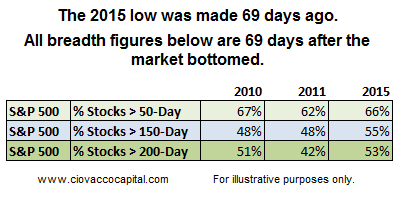
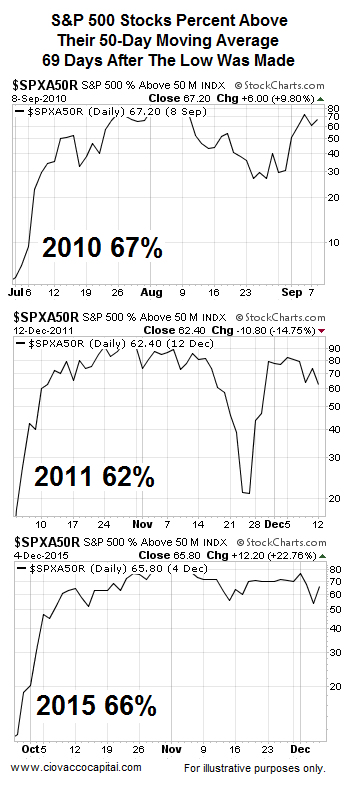
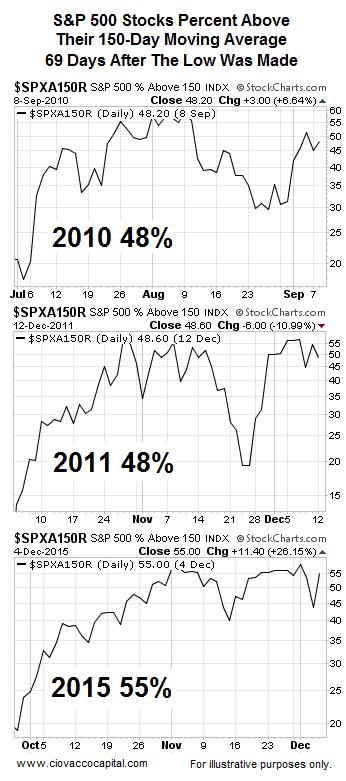
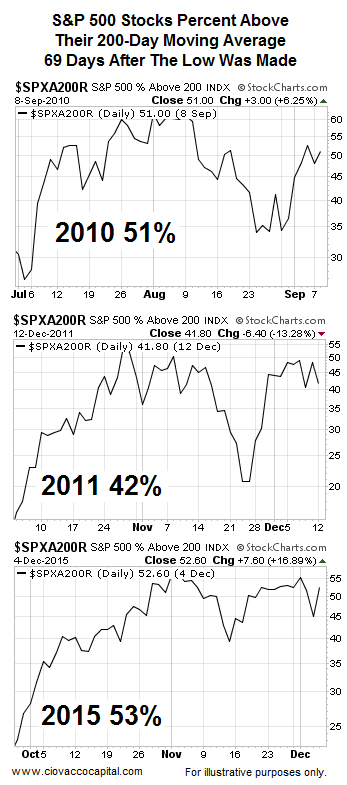
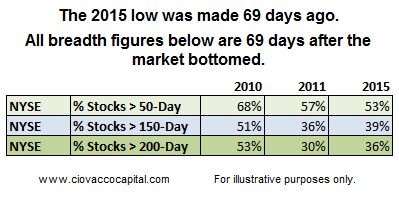

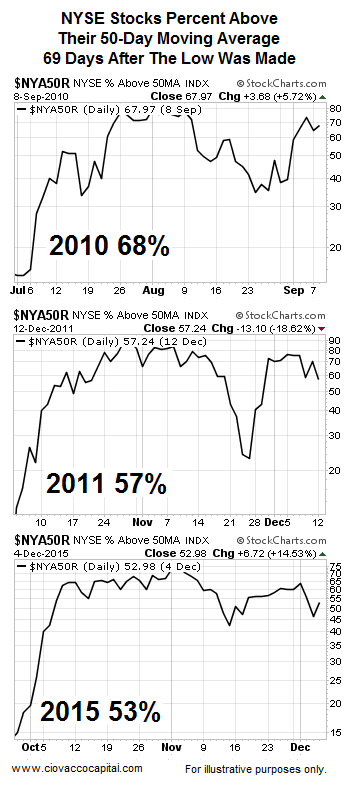
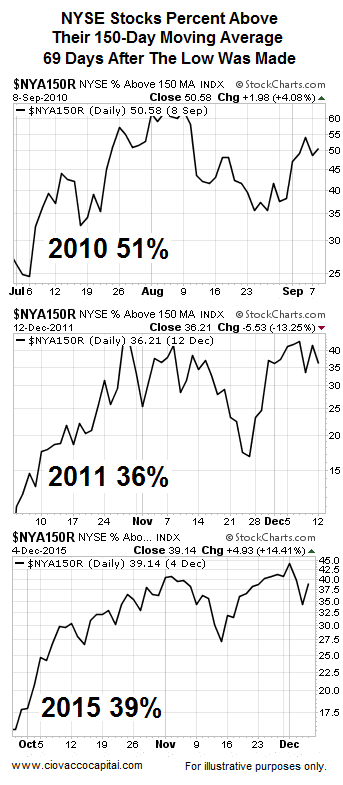

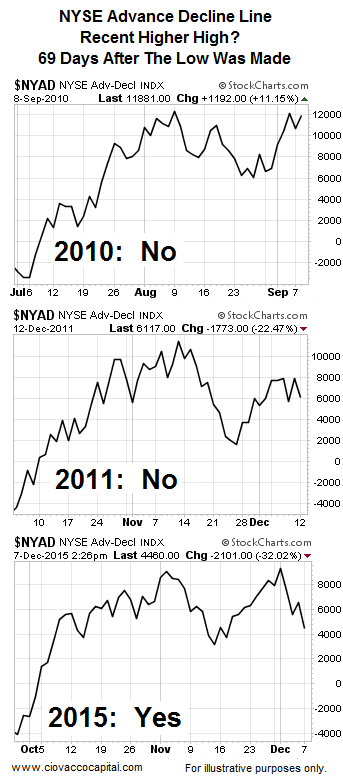
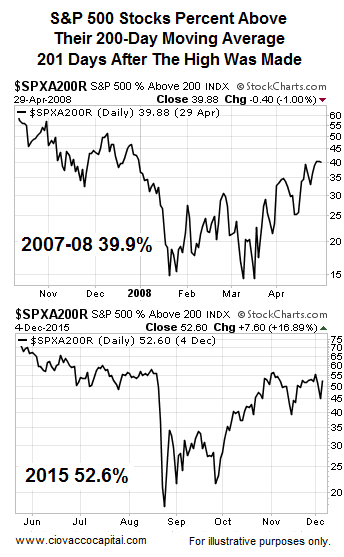
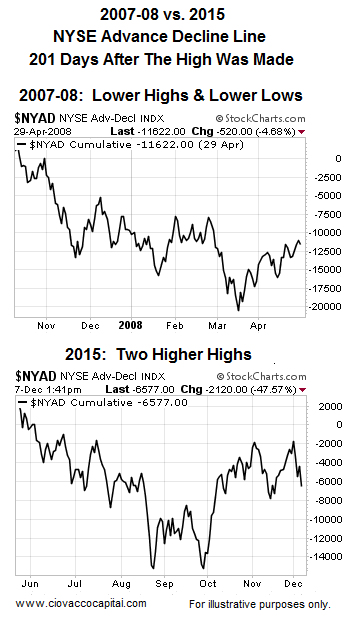
Speak Your Mind